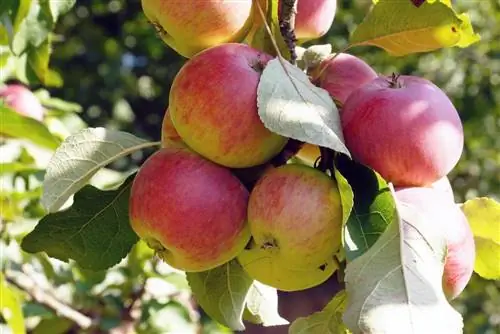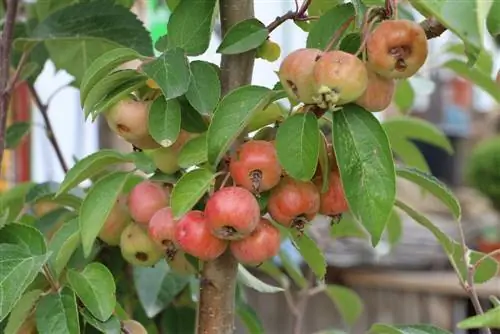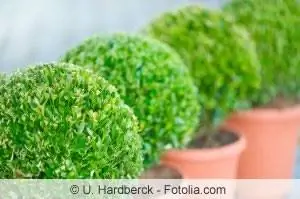- Author admin [email protected].
- Public 2023-12-17 03:39.
- Last modified 2025-01-24 12:45.
If you want to plant an apple tree, you have to consider a few things before digging the planting hole. This includes, above all, choosing the right location, the right time for planting and the distance to other plants and buildings. If these factors are taken into account, thought through and well planned, the best basis is laid for many years of rich harvests. With the crucial knowledge about the first steps and the required care, neither a green thumb nor experience is required.
Location
Apple trees should be kept as sunny as possible and protected from cold winds. A southern orientation in a slightly elevated position as well as protection in the form of hedges, walls or walls at a sufficient distance are ideal.
Sinks, on the other hand, are unfavorable because cold air and water can collect here. It should also be borne in mind that large apple trees can sooner or later cast a lot of shade. So you shouldn't be in close proximity to plants that need a lot of light.
Distance
There is no general answer to how much distance should be maintained between the apple tree and buildings, other plants or fences. Anyone who wants to plant an apple tree must first and foremost take into account the growth habit or breeding or desired shape. A standard tree with a sprawling crown requires a distance of up to ten meters from larger “obstacles”. An espalier apple tree or columnar fruit only about two meters. So here you have to decide depending on the variety.
Tip:
The apple tree should of course be chosen to suit the available space. If the tree is later to provide shade, sprawling tall trunks make sense - if there is little space, however, columnar fruit.
Substrate
Apple trees are rather undemanding when it comes to substrate. However, the following factors are important:
- loose texture, does not tend to compact
- moderate nutrient content, mixture of mature compost and garden soil
- moderately moist but not wet
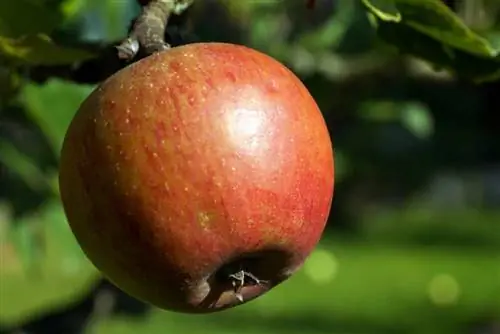
Places with high groundwater or a location where water collects due to close proximity to bodies of water or a depression are therefore extremely unsuitable. If the soil is clayey and tends to become compacted, mixing in sand can help.
Preparation
If you want to plant an apple tree, you should ideally prepare the planting hole at least four weeks before planting. To do this, proceed as follows:
- A hole at least 50 centimeters deep and wide is dug at the desired planting site.
- The turf is removed, the excavated soil is loosened, freed of foreign bodies and mixed with ripe compost. If necessary, sand can be added to loosen the substrate.
- If the soil is very dry, you can water it once to slurry the substrate.
This preparation allows the nutrients to settle and can also be processed by soil organisms.
Tip:
As a shallow rooter, the apple tree should be limited when planted close to paths. It is advisable to apply a root barrier in advance here. This also prevents the sensitive roots from being injured.
Plants
When planting the apple tree, the following steps are important:
- The prepared planting hole is dug and the apple tree is planted so that the grafting point is ten centimeters above the ground.
- The soil is added little by little and the tree is shaken slightly so that the substrate is well distributed between the roots.
- If necessary, a stabilizing post is inserted and the trunk is attached to it.
- The substrate is tapped into place layer by layer and then the top layer is carefully pressed down to prevent it from sinking later.
- The soil is poured so that even the lowest layers are well moistened.
Tip:
Bare-rooted apple trees should be soaked in water or a mixture of water and compost for about an hour immediately before planting. For trees in a pot, however, the substrate is carefully rinsed off.
Time
The apple tree can in principle be planted all year round. However, the growing season from autumn to spring is favorable. In any case, a frost-free day should be chosen. October to November has proven to be optimal, as the tree can then take root well until next year.
Pouring
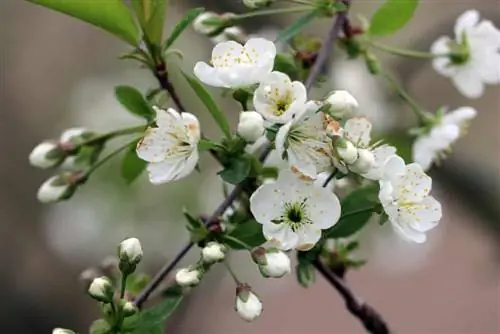
The purpose of the first watering of the apple tree is to provide the plant with moisture. In addition, so-called slurrying is also important in order to distribute the substrate evenly to the roots and eliminate air pockets. Following the first watering, the apple tree should be kept slightly moist during the initial period. Here, watering is not carried out directly on the trunk, but rather at a short distance around the tree disc in order to pull the roots in the desired direction. To ensure efficient watering, a small depression can be made in the soil at an even distance from the trunk.
This gutter directs the water specifically into the ground. For very young apple trees and during the first year, care should be taken to ensure that the soil does not dry out. In summer and when there is little precipitation, water should be moderate. However, waterlogging should be avoided as apple trees are very sensitive to it.
Fertilize
If compost was mixed into the soil when planting the apple tree, further fertilization during the first year is unnecessary. As a rule, the nutrients even last beyond the second year without any problems. Fertilizing is only necessary in the third year and even then should only be carried out moderately. Compost is again suitable for this, but also manure and occasionally blue grain. One gift per year is sufficient. The selected fertilizer is applied to the tree disc and only lightly worked into the soil. Then water heavily so that the nutrients can be distributed.
Blend
The first cutting should be done immediately after planting the apple tree, unless it has already been done in the nursery. This so-called planting cut serves, on the one hand, to form shape and, on the other hand, to conserve strength. With this blend, the crown is reduced to the main trunk and four to six strong side shoots. Branches that grow inwards or cross each other are removed so that the crown is airy and light from the start. The blending can then be carried out from autumn to spring. Ideally, the care measure should be carried out before the apple tree produces new shoots. If necessary, it can still be cut even if there are already flowers.
Although this time is not ideal for the tree, it has an advantage for anyone who is very unsure about pruning. Because branches with very few buds or flowers can be better recognized as low-yielding and specifically removed.
Alternatively, these shoots can also be marked and then cut in autumn or winter. In any case, it is of course important to ensure that clean cutting tools are used and, if possible, that cutting is done in the morning on a dry day. This allows the resulting wounds to close more quickly and the risk of pathogen infestation is reduced.
Pollination
In order for the apple tree to produce fruit at all, there should be a second apple tree in the immediate vicinity. Alternatively, a two to four variety apple tree can be planted. These have several noble shoots placed on one base so that the varieties pollinate each other and different types of apples can be harvested from the same tree.
Conclusion
Planting an apple tree requires some preparation, but the right approach and appropriate care are rewarded with rapid and vigorous growth. In addition, the considerations at the beginning save the effort of moving or even cutting down the apple tree early.

